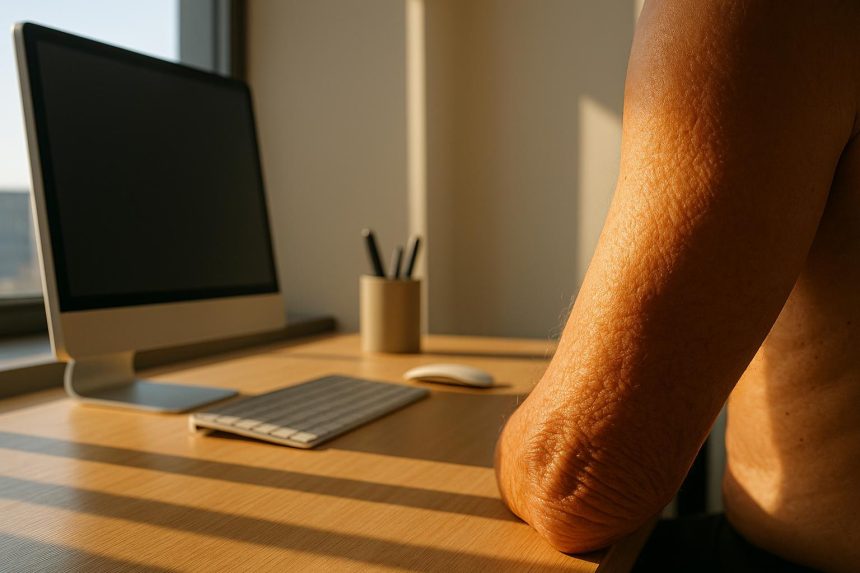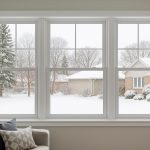The Rise of Office Tan: How Indoor Light Ages Your Skin
Did you know that fluorescent office lighting emits the same UV radiation that causes sunburn? Indoor lighting creates measurable changes in skin structure through multiple wavelengths of light exposure. Office workers receive extended artificial light exposure daily, with fluorescent bulbs emitting UV radiation at 365-400 nanometers and LED screens producing high-energy visible (HEV) blue light at 400-500 nanometers. This constant exposure triggers melanin production, collagen breakdown, and oxidative stress in skin cells, creating what dermatologist Singapore experts now recognize as photoaging from indoor sources.
The phenomenon differs from traditional sun damage because indoor light penetrates skin at consistent, low intensities throughout the day. Indoor fluorescent lighting maintains steady UV output, while computer screens add blue light exposure directly to facial skin from close distances. A dermatologist consultation reveals these cumulative effects through specialized skin analysis showing hyperpigmentation patterns distinct from sun exposure.
Indoor Light Sources and Skin Damage Mechanisms
Fluorescent office lighting contains mercury vapor that produces UV radiation when electrical current passes through. Standard T8 fluorescent tubes emit UVA at 365-400nm and minimal UVB at 280-315nm wavelengths. The plastic diffusers covering these lights filter some radiation but allow UV transmission. Sitting near overhead fluorescent fixtures exposes skin to radiation levels over extended periods.
LED panels and computer monitors generate blue light through semiconductor diodes that produce photons at 450-490nm peak wavelengths. This blue light penetrates deeper than UVA radiation, reaching the dermis where collagen and elastin fibers reside. Blue light exposure creates oxidative stress. Laptop screens positioned at typical working distances deliver blue light directly to facial skin.
Halogen desk lamps produce infrared radiation and heat alongside visible light. The tungsten filaments reach temperatures of 2,500-3,000 Kelvin, emitting wavelengths from 300-2,500nm. Prolonged exposure to halogen lighting within close range may cause thermal damage to skin proteins and accelerate trans-epidermal water loss. The combination of heat and light exposure creates conditions similar to sitting near a fireplace for extended periods.
💡 Did You Know?
Window glass in modern offices blocks UVB rays but allows most UVA radiation to pass through. Sitting by a window for your entire workday exposes you to UVA radiation.
Recognizing Indoor Photoaging Signs
Melasma patterns from indoor light appear as symmetrical brown patches on the cheeks, forehead, and upper lip, with edges that blur gradually into surrounding skin. Unlike sun-induced melasma with sharp demarcation lines, office-induced pigmentation develops slowly over months with diffuse borders. The pigmentation shows gray-brown coloration under Wood’s lamp examination.
Fine lines around the eyes develop asymmetrically based on computer screen positioning. The side of the face closer to the primary monitor shows increased crow’s feet development, with wrinkles deeper than the opposite side after years of consistent desk work. Periorbital wrinkles extend further toward the temples on the screen-facing side, creating an uneven aging pattern visible in standardized photography.
Skin texture changes manifest as enlarged pores on the nose and cheeks after prolonged indoor light exposure. The skin surface develops a rough, sandpaper-like texture detectable through tactile examination. Sebaceous glands increase oil production in response to blue light, leading to combination skin patterns even in previously normal skin types.
Vascular changes include persistent facial redness and visible capillaries on the cheeks and nose. Indoor heat and light exposure dilates blood vessels, making them visible through the epidermis. This telangiectasia pattern differs from rosacea by remaining stable rather than fluctuating with triggers.
Protection Strategies for Office Workers
Physical barriers provide protection against indoor light exposure. Mineral sunscreens containing zinc oxide or titanium dioxide create a reflective shield against blue light and UV radiation. Application every morning blocks incoming light wavelengths. Reapplication frequency should be determined based on individual needs and product specifications.
Computer screen filters reduce blue light emission depending on filter specifications. Orange-tinted filters provide protection while maintaining color accuracy for most office tasks. Screen brightness reduction decreases overall light exposure without compromising visibility. Positioning monitors at arm’s length reduces light intensity reaching facial skin.
Antioxidant serums containing L-ascorbic acid, ferulic acid, and vitamin E neutralize free radicals generated by light exposure. Morning application under sunscreen provides dual protection against oxidative damage. Niacinamide reduces melanin transfer between cells, preventing pigmentation formation. Retinoids applied nightly accelerate cell turnover to remove damaged cells.
⚠️ Important Note
Blue light protection requires different ingredients than traditional UV sunscreens. Iron oxides provide the specific protection needed against visible light wavelengths that standard UV filters miss.
Office Environment Modifications
Desk positioning away from windows reduces ambient UV exposure while maintaining natural light benefits. Placement that puts windows at 90-degree angles to computer screens prevents direct light exposure to facial skin. UV-filtering window films block UVA radiation and maintain visibility while eliminating harmful wavelengths.
Lighting adjustments using warm-white LED bulbs reduce blue light exposure compared to cool-white options. Task lighting with adjustable arms allows positioning to minimize facial exposure while illuminating work surfaces. Smart bulbs with programmable color temperatures shift from cool morning light to warm afternoon light, mimicking natural circadian rhythms while reducing cumulative blue light exposure.
Monitor settings optimization includes activating built-in blue light filters available in operating systems. Windows Night Light and Mac Night Shift reduce blue emissions through color temperature adjustment. Monitors with flicker-free technology and low blue light modes provide hardware-level protection. Ambient bias lighting behind monitors reduces contrast stress and overall screen brightness requirements.
✅ Quick Tip
The 20-20-20 rule protects both eyes and skin: every 20 minutes, look at something 20 feet away for 20 seconds. This break reduces concentrated light exposure to periorbital skin while preventing eye strain.
Treatment Options for Existing Damage
Chemical peels using glycolic acid or trichloroacetic acid remove photodamaged surface cells. Treatment depths target specific skin layers based on damage severity. Recovery requires several days for superficial peels and up to two weeks for medium-depth treatments. Serial treatments every few weeks progressively improve pigmentation and texture changes.
Laser treatments with Q-switched Nd:YAG target deeper pigmentation without damaging surrounding tissue. Picosecond lasers deliver energy rapidly, shattering pigment particles for natural elimination. Fractional CO2 lasers create microscopic treatment zones, stimulating collagen remodeling. Treatment sessions spaced several weeks apart allow complete healing between procedures.
Intense Pulsed Light (IPL) addresses both pigmentation and vascular changes simultaneously. Light pulses heat targeted chromophores while cooling mechanisms protect surrounding skin. Treatment parameters adjust for different skin types, with lower fluences for darker skin tones. Monthly sessions over several months achieve correction of indoor photoaging signs.
Prescription treatments including hydroquinone, tretinoin, and mild corticosteroids in triple combination therapy address stubborn pigmentation. Application protocols should be determined by a healthcare professional. Tranexamic acid provides non-hydroquinone alternatives for melasma management. Oral supplements containing polypodium leucotomos extract provide systemic photoprotection.
What Our Dermatologist Says
Indoor photoaging develops through cumulative micro-damage rather than acute injury. Patients often dismiss indoor light exposure because they don’t experience immediate burning or tanning. However, skin biopsies reveal cellular changes identical to sun damage, including elastin degeneration and abnormal melanocyte activity. The damage accumulates subclinically for years before becoming visible.
Treatment outcomes depend on simultaneous protection and repair strategies. Removing existing damage without preventing ongoing exposure leads to rapid recurrence. Patients who combine daily photoprotection with targeted treatments see improvement. Those who modify their office environment alongside skincare routines maintain results longer than those relying on products alone.
The concept of “computer face” describes the specific aging pattern seen in office workers: forehead lines from screen glare, asymmetric crow’s feet, and melasma on screen-facing cheeks. This pattern differs from traditional photodamage and requires targeted intervention strategies addressing both prevention and correction.
Conclusion
Indoor light exposure causes measurable skin damage through UV radiation from fluorescent bulbs and blue light from screens. Protection requires daily mineral sunscreen with iron oxides, blue light screen filters, and workspace modifications. Existing damage responds to professional treatments including chemical peels, laser therapy, and prescription topicals targeting pigmentation and texture changes.
If you’re experiencing brown patches, asymmetric fine lines, or skin texture changes from daily screen and fluorescent light exposure, a dermatologist can evaluate your specific damage pattern and recommend targeted treatment options.
Lynn Martelli is an editor at Readability. She received her MFA in Creative Writing from Antioch University and has worked as an editor for over 10 years. Lynn has edited a wide variety of books, including fiction, non-fiction, memoirs, and more. In her free time, Lynn enjoys reading, writing, and spending time with her family and friends.















